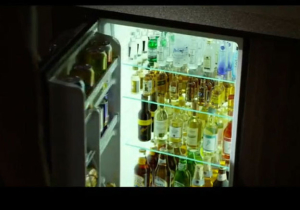 Product Placement Fight over Flight
Product Placement Fight over Flight
If you’ve seen the movie “Flight,” you were probably able to recognize some of the bottles of alcohol that Denzel Washington’s character was drinking. Companies will often pay to have their product placed in a movie or TV show, or, at the very least, allow the use of their product in media outlets because they value the free advertising. However, Anheuser-Busch, the makers of Budweiser, and William Grant & Sons, the distributors of Stolichnaya in the United States, are unhappy with the use of their products in “Flight.”
Washington plays a pilot who abuses drugs and alcohol. Both A-B and Grant have stated they did not give permission for their products to be used in the movie, and A-B has asked Paramount Pictures to obscure or remove the Budweiser logo from the film. However, Paramount is unlikely to be in any serious legal trouble for the use of these products in the film.
In fact, Paramount has won this battle before. In Wham-O Inc. v. Paramount Pictures Corp., the makers of SLIP AND SLIDE sued Paramount for using their product in the movie “Dickie Roberts: Former Child Star.” In that movie, David Spade’s character jumps belly first on the yellow plastic sheet without first inflating it with air and water. After it doesn’t work, he pour oil on the slide, and using it again, crashes right into a fence. Paramount did not ask Wham-O for permission to use the SLIP AND SLIDE as part of their movie. Wham-O sued Paramount for trademark dilution and infringement.
Trademark dilution and trademark ingringement are two different claims, so let’s look at each of these. Wham-O argued that Paramount was liable for both types of trademark dilution: blurring and tarnishment.
- Blurring occurs when the use of another’s mark creates the possibility the mark will lose its ability to serve as an identifier of the owner’s product. So if I use a name that’s similar to your trademark in such a way that your mark is diminished, I may be liable for trademark dilution by blurring.
- Tarnishment occurs when a famous mark is wrongly associated with an inferior or offensive product or service and that association creates the possibility that consumers will form negative opinions or beliefs about the mark.
Wham-O claimed that Paramount’s use of the SLIP AND SLIDE in their movie – which was not exactly a high-class Oscar candidate – tarnished the trademark. Because of the misuse of the slide in the film, Wham-O claimed that consumers would perceive the SLIP AND SLIDE trademark in a negative light. The court disagreed with this argument, however, because they found that the misuse of the slide in the movie would be obvious and unmistakable. Because the misuse was so recognizable, the court did not believe anyone would think the SLIP AND SLIDE was an inferior or offensive product. Therefore, there was no tarnishment. As for blurring, the court held that the plaintiff’s complaint didn’t state a claim that the SLIP AND SLIDE trademark would lose its ability to serve as an identifier of Wham-O’s product. Instead, Wham-O appeared to be concerned that consumers would associate the slide with Wham-O too much, and that association would make their product look somehow dangerous. This is referred to as “over-attribution,” which is not a concern in an analysis of trademark dilution through blurring. Therefore, the court dismissed Wham-O’s “blurring” claim as well.
Finally, the court held that there was no trademark infringement because the defendant’s use of the plaintiff’s trademark did not create a likelihood that the public would be confused as to who makes what product. As my faithful readers will recall, likelihood of confusion is the threshold in determining whether there has been trademark infringement. The movie did not present the SLIP AND SLIDE trademark in connection with a product derived from Paramount or some company other than Wham-O. To put it another way, Paramount wasn’t using the mark SLIP AND SLIDE as a trademark for their own goods or services. As a result, there could be no confusion as to who owned the SLIP AND SLIDE mark. The use of the mark was “nominative,” and therefore, there was no irreparable injury to the plaintiff.
A similar analysis could be applied to “Flight.” Washington’s character was an alcoholic. It is that direct “misuse” of the alcoholic products that lead to Washington’s character’s troubles, not the trademarks themselves. Even Budweiser stated that the products were being misused. “We would never condone the misuse of our products, and have a long history of promoting responsible drinking and preventing drunk driving,” Rob McCarthy, vice president of Budweiser, wrote. Furthermore, as in the “Dickie Roberts: Former Child Star” case, nothing in the movie “Flight” would lead consumers to believe that the marks were owned by Paramount. There is no likelihood that the consuming public will watch the movie and be confused as to who owns the alcohol trademarks. The use of the marks was important to the story, and the most likely outcome is that it was fair for Paramount to use the marks in this manner.

